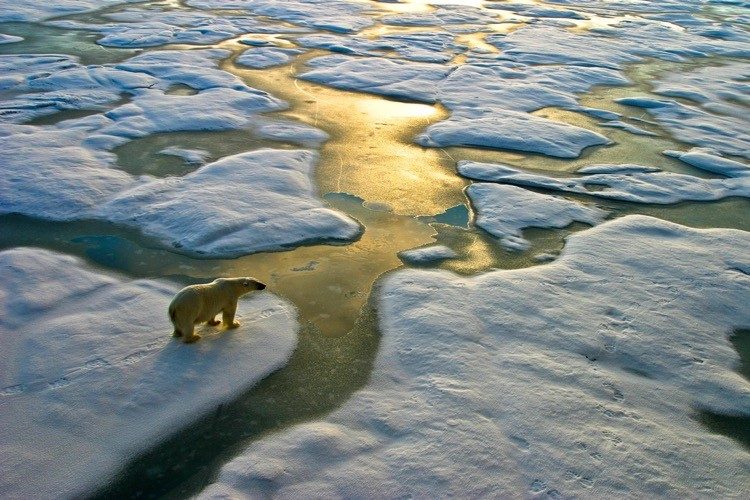
It’s a conclusion that aligns with now-uncommon common sense: As has occurred all throughout history, it’s natural phenomena that are causing climate change. In this case, Russian researchers have found that great earthquakes are causing Arctic warming.
As the Free Press Journal reported Sunday:
In the Arctic, one of the factors driving climate warming is the release of methane from permafrost and metastable [largely unstable] gas hydrates in the shelf zone. The study published in the journal Geosciences attempted to offer an explanation for abrupt temperature changes observed in the region.
Global warming is widely believed [by pseudo-elites] to be caused by human activity, which increases the concentration of greenhouse gases in the atmosphere. However, this view does not explain why temperatures sometimes rise fairly abruptly.
Since researchers began to monitor temperatures in the Arctic, the region has seen two periods of abrupt warming: first in the 1920s and ’30s, and then beginning in 1980 and continuing to this day. In his paper, Leopold Lobkovsky from Moscow Institute of Physics and Technology in Russia hypothesised that the unexplained abrupt temperature changes could have been triggered by geodynamic factors.
Phys.Org provides more detail, writing that, specifically, Lobkovsky
pointed to a series of great earthquakes in the Aleutian Arc, which is the closest seismically active area to the Arctic.
To test his hypothesis, Lobkovsky had to answer three questions. First, did the dates of the great earthquakes coincide with temperature jumps? Second, what is the mechanism that enables the lithospheric disturbances to propagate over more than 2,000 kilometers from the Aleutian Islands to the Arctic shelf region? Third, how do these disturbances intensify methane emissions?
The answer to the first question came from historical data analysis. It turned out that the Aleutian Arc was indeed the site of two series of great earthquakes in the 20th century (more details below the text). Each of them preceded an abrupt rise in temperature by about 15 to 20 years.
It took a model of lithospheric excitation dynamics to answer the second question. The model used by the researcher describes the propagation of so-called tectonic waves and predicts that they should travel at about 100 kilometers per year. This agrees with the delay between each of the great earthquake series and the subsequent temperature hike, as it took the disturbances 15 to 20 years to get transmitted over 2,000 kilometers.
To answer the third question, the researcher proposed the following explanation: The deformation waves arriving in the shelf zone cause minor additional stresses in the lithosphere, which are sufficient to disrupt the internal structure of the metastable gas hydrates and permafrost storing captured methane. This releases methane into the water of the shelf and atmosphere, leading to climate warming in the region due to the greenhouse effect.
In summary, Lobkovsky says there’s a definite correlation between Aleutian Arc earthquakes and climatic warming phases.
However valid, Lobkovsky’s findings are hardly alone in casting doubt on the man-caused global warming thesis. For example, consider the following points:
- Climate data appear very unreliable, and many scientists say that the temperature ceased rising approximately 20 years ago. Moreover, insofar as the climate is changing — and it always does — there’s no proof man’s activities are responsible.
- The claim that “97 percent of scientists affirm” man-caused global warming was always false. There’s much disagreement on the matter, and, besides, “consensus” isn’t a term of science, but politics.
- CO2 is not a pollutant, but plant “food,” which is why botanists pump it into greenhouses and why crop yields are greater when levels are higher; it’s why the age of the dinosaurs, when CO2 levels were six to seven times today’s, was characterized by lush foliage everywhere. Also, calling CO2 “carbon” is like calling H2O “hydrogen” — it’s a propaganda term.
- In fact, astrobiologist Jack O’Malley-James warned in 2013 that life on Earth will end because of too little CO2 (in approximately one billion years). Plants can’t photosynthesize when levels are too low.
- Some scientists believe that we’re actually poised to enter another ice age; this would be truly dangerous because people and animals generally fare better in warmer temperatures.
- Danish statistician Bjørn Lomborg, the head of the Copenhagen Consensus Center, calculated in 2017 that reducing the global temperature three-tenths of one degree by the century’s end — meaning, postponing so-called “global warming” less than four years — would cost $100 trillion (no, that’s not a typo).
- Climate models have been consistently inaccurate, yet alarmists still want them to shape policy. Is this logical? Would you take a “hot stock tip” from a broker who’d been consistently wrong for more than a generation?
- Doomsday prognostications have been no better. Professor Paul Ehrlich, Population Bomb author, predicted in 1968 that a famine would cause “hundreds of millions of people … to starve to death” in the United States in the 1970s and that by 1999, our population would have declined to 22.6 million, reported the late Professor Walter E. Williams in his 2008 article “Environmentalists’ Wild Predictions.”
One prediction that can be banked on, however, is that when a certain doomsday climate of fear serves to increase politicians’ power and taxation capacity, that climate will not soon be changed.



